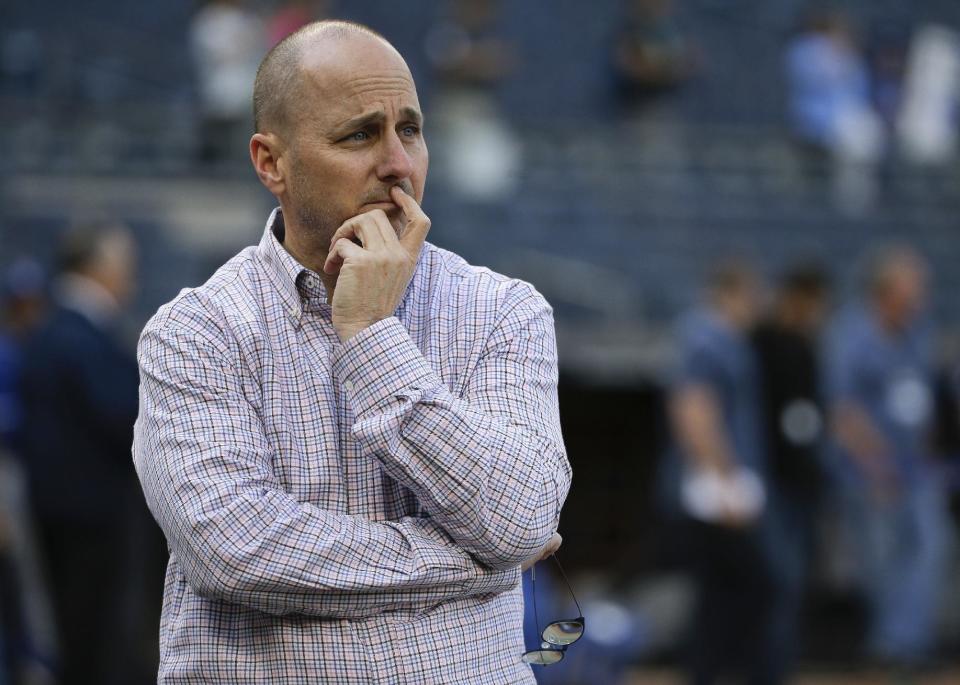The New York Yankees are … sellers?

Brian Cashman has been around long enough, won enough and lost enough and endured enough, to know the rules of the crapshoot. Which are, there are no rules.
What there are, instead, are opportunities, assuming they are not traps. This time of year, with 59 games ahead of the New York Yankees, and three teams ahead of them in the AL East, and a reasonable chance at relevance if not a promise for it, those openings may not be there long.
And so, against the backdrop of who the Yankees are and what they’ve seemingly always been, along with an industry that doesn’t tend to its dynasties like it used to, and in a mid-summer market that has rediscovered the eighth and ninth innings, Cashman considered today, considered tomorrow – “We’re dancing on both,” he said – and over five days sold off his eighth and ninth innings.
Aroldis Chapman was traded to the Chicago Cubs for three prospects – of which shortstop Gleyber Torres became the Yankees’ top prospect and outfielder Billy McKinney was ranked 13th – and reliever Adam Warren. Then, Sunday morning, Cashman traded Andrew Miller to the Cleveland Indians for four more young players, including the Indians’ best prospect (outfielder Clint Frazier, who immediately supplanted Torres as the Yankees’ top prospect) and another high-ender (lefty Justus Sheffield).
Neither trade made the Yankees more likely to beat the Tampa Bay Rays on Sunday in St. Petersburg. Neither would help them make up 6½ games on the Toronto Blue Jays in the AL East, or recover the four games necessary to catch the Boston Red Sox in the wild-card race. Tyler Clippard was acquired from Arizona on Sunday to soften the blows to the bullpen, which is fine, because Clippard is reliable and often effective, his past few outings (2⅓ innings pitched, seven runs allowed) notwithstanding.
Cashman spoke Sunday, 28 hours before the trade deadline. Threading out two important pitchers honored a moment in time that, he said, played well. “You’d exploit this market pretty strongly if you were willing to delve into those waters,” he said.
These are not the juggernaut Yankees. These are the realistic Yankees, trudging along near .500, lugging gluttonous contracts and playing to about where most – if not Cashman – expected them. These are not, Cashman said, the surrendering Yankees, despite appearances. Yankees are not supposed to surrender. They are supposed to blow out the farm system for reinforcements until circling back on the big free agents, except luxury tax thresholds and draft slotting systems and international caps have conspired to make farm systems even more precious, even to the Yankees.
Twenty years ago they began a run that featured Derek Jeter, Bernie Williams, Andy Pettitte, Jorge Posada and Mariano Rivera, among others. So, yeah, farm systems. Tomorrows. Hard decisions about what’s ahead for a 52-51 team 12th in the American League in runs and below average in starters ERA.
A lot was made of the Yankees being trade deadline sellers for the first time since Rickey Henderson and Mike Pagliarulo were dealt in the summer of 1989. Well, the Yankees haven’t had a losing season since 1992. So, the game changes, even for them.
As Cashman said, “Stay tuned. A lot more things could happen. Could be additions. Could be subtractions,” this shortly after summarizing the coming 24 hours thusly: “We are in buy, sell, long, short mode.”
That could mean Ivan Nova. It could mean Carlos Beltran. Or neither.
The new Yankees have a powerhouse farm system. The new Yankees might’ve just sold themselves out of 2016. The new Yankees are bracing themselves for the crapshoot of both, dancing to whatever and with whomever comes along.
As for the rules?
“Let’s just see,” Cashman said, “where the rest of this stuff takes me.”

